

|
THE BIG AIRPLANE AT LOWRY PARK 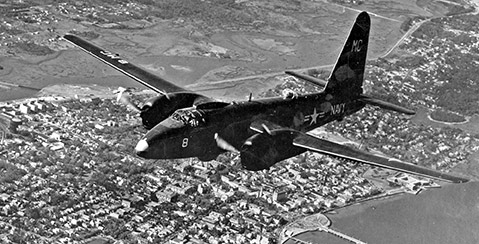 The
big airplane at Lowry Park was a U.S. Navy P2V-3 Neptune; a patrol bomber used by the
Navy to detect enemy surface ships and submarines. The
big airplane at Lowry Park was a U.S. Navy P2V-3 Neptune; a patrol bomber used by the
Navy to detect enemy surface ships and submarines.
The Neptune was the
primary U.S. land-based anti-submarine patrol aircraft developed near the end of
World War 2 and was intended to be operated as the hunter of a "Hunter-Killer"
group, with destroyers employed as killers during the Korean and early Cold War
years. It was eventually replaced by the P3 Orion in the mid-1960s.
This particular airplane was serial number 122944 and flew submarine bomber command patrol training missions out of the Jacksonville Naval Air Station during the early 1950s. It was armed with 20 mm cannon, bombs, torpedoes, depth charges, mines and rockets, and carried a crew of eight. It had a 100-foot wing span, was 77 feet long and had a max speed of 267 mph.
By the late 1950s, this type of airplane was becoming obsolete--submarines were getting more sophisticated and could stay underwater for a month, and it was not feasible for the Navy to spend the money to keep this type of aircraft maintained.
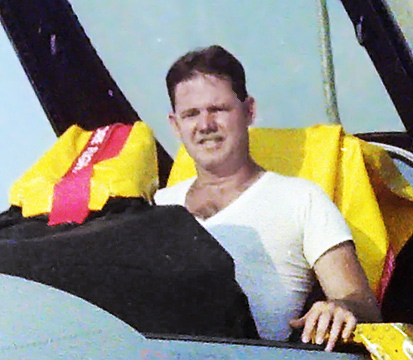 Dennis Cole, former president of the Yesterday's
Air Force Museum which was located at the St. Pete-Clearwater Airport, recently
shared his knowledge of the history and restoration of this airplane with TampaPix. Dennis Cole, former president of the Yesterday's
Air Force Museum which was located at the St. Pete-Clearwater Airport, recently
shared his knowledge of the history and restoration of this airplane with TampaPix."The aircraft was on loan to the City of Tampa from the U.S. Navy. They [Tampa] were responsible for its display in accordance with Navy directives; the aircraft was still Navy property, not the property of the city, the park or any other entity." |
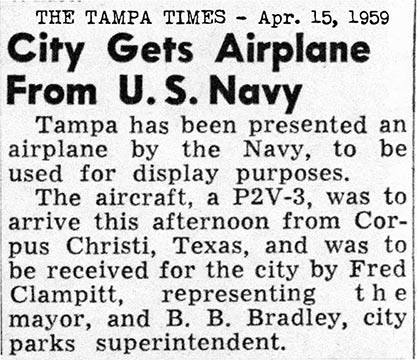 THE AIRPLANE ARRIVES IN TAMPA The big airplane arrived in Tampa from Corpus Christi, Texas, on April 15, 1959 and was presented to Fred Clampitt (Mayor Nuccio's administrative assistant) and Buford B. Bradley, Tampa's city parks superintendent. Clampitt took over this position in 1958 after D. M. Allison "failed to measure up to the job" according to the mayor. It is not yet known what the circumstances were that led to the Navy sending the airplane to Tampa, but Mayor Nick Nuccio probably played a major role. The plans were to have actor Kirby Grant, the "Sky King," dedicate the airplane at its display location, Lowry Park. Contrary to some local unofficial Tampa tales, this wasn't Sky King's airplane and he didn't fly it to Lowry Park. |
|
"From out of the clear blue of the western sky comes Sky King!"
This was the familiar opening to television's premier aviation program. Sky King was an American radio and television series whose lead character was Arizona rancher and aircraft pilot Schuyler "Sky" King. The radio show began in 1946 and was based on a story by Roy Winsor, the brainchild of Robert Morris Burtt and Wilfred Gibbs Moore, who also created Captain Midnight. Several actors played the part of Sky, including Earl Nightingale and John Reed King. The television show was
first broadcast on Sunday afternoons on NBC-TV between September 16,
1951, and October 26, 1952. These episodes were rebroadcast on ABC's
Saturday morning lineup the following year from November 8, 1952 through
September 21, 1953 when it made its prime-time debut on ABC's Monday
night lineup. It was telecast twice a week in August and September 1954,
before ABC cancelled it. New episodes were produced when the show went
into syndication in 1955. |
|
||||||
|
The last new episode,
"Mickey's Birthday", was telecast March 8, 1959. "Mickey" was a kinsman
of Sky King portrayed in three 1959 episodes by child actor Gary Hunley.
Thereafter, Sky King surfaced on the CBS Saturday schedule in reruns
until September, 1966. The television version starred Kirby Grant as Sky King and Gloria Winters as Penny. Other regular characters included Sky's nephew Clipper, played by Ron Hagerthy, and Mitch the sheriff, portrayed by Ewing Mitchell. Mitch, a competent and intelligent law enforcement officer, depended on his friend Sky's flying skills to solve the harder cases. Other recurring characters included Jim Bell, the ranch foreman, played in four episodes by Chubby Johnson, as well as Sheriff Hollister portrayed by Monte Blue in five episodes, and Bob Carey, portrayed in ten episodes by Norman Ollestad.
King and his niece Penny (and sometimes her brother, Clipper) lived on the Flying Crown Ranch, near the fictitious town of Grover, Arizona. Penny and Clipper were also pilots, although they were inexperienced and looked to their uncle for guidance. Penny was an accomplished air racer, rated as a multiengine pilot, whom Sky trusted to fly the Songbird. Operating from his
ranch, Sky King, Penny and their airplane "Songbird" were constantly
involved in one adventure after another. King usually captured criminals
and spies and found lost hikers, with the use of his airplane. Two
twin-engine Cessna airplanes were used by King during the course of the
TV series. The first was a Cessna T-50 and in later episodes a Cessna
310B was used till the series' end. The 310's make and model type number
was prominently displayed during the closing titles. Viewed by many
children in the 1950s, this program was responsible for inspiring many
later aviation careers.
|
|||||||
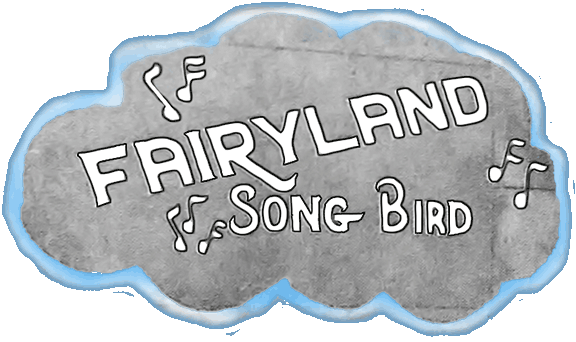
|
1959-APRIL 20: THE BIG NAVY AIRPLANE DEDICATION The airplane was towed from the Tampa airport to a location just outside the amusement rides at Fairyland. In 2001, Richard Long, son of James D. Long, said that his father gave visiting dignitaries a tour of the airplane and was the one who towed it from Tampa International Airport at Columbus Drive and Westshore Blvd. to the park. At the dedication, Mayor Nuccio bent down and kissed Richard's sister, Barbara Long, on the cheek. |
|
|
HE'S A KING ON THE GROUND, TOO |
HERO OF THE SMALL FRY Youngsters crowded around TV star Kirby Grant, whom they knew as Sky King, when he appeared at Tampa's Fairyland Park yesterday to dedicate a surplus military aircraft acquired by Mayor Nuccio last week for the children's park. It was appropriately named the "Fairyland Song Bird" after Sky King's TV airplane, the Songbird. (The Tampa Tribune - Apr. 21, 1959) |
|
|
|
|
|
|
|
"Sky King" Kirby Grant entertaining a group at Cesar Gonzmart's Rocky Point Beach Restaurant. |
Kirby Grant having lunch at Cesar Gonzmart's Rocky Point Beach Restaurant after having been presented with a key to the City of Tampa by Mayor Nick Nuccio (not pictured.) |
|
This screen shot from a YouTube video collection of short episodes of "The Ferris Wheel Caper" filmed at Lowry Park in 1962 starring "Barney Bungelupper" and "Uncle Bruce" shows the airplane in its original condition and named the FAIRYLAND "Song Bird" after Sky King's airplane.
By the late 1960s to early 70s, the airplane was
covered in graffiti and sorely needed some TLC.
May 19, 1965
The airplane seen here recently painted deep
blue, circa 1972.
1973
Seen here around
1976, sporting a patriotic color scheme and "76" logo to celebrate the
Nation's
upcoming bicentennial, sits the big airplane that for many years was a drab, fadded blue-gray
"jungle gym" for adventurous kids yearning to climb something.
Notice on the far left; the muscle-powered swinging cages.
Mark Elmore with the airplane, early 1980s.
Photo and date from eBay postcard seller BondgirlFL
|
|
TIME TO GO The 1980s brought about some major changes at Lowry Park, especially at the zoo. In the early 1980s the plan to start a multi-million dollar major improvement of the zoo began to be discussed. Eventually, the airplane, then the choo-choo, would be removed. Jay Wisler, the boy who played in the airplane along with the son of parks superintendent B.B. Bradley, was the president of "Yesterday's Air Force" which had ambitions to set up an aerial museum at the St. Petersburg-Clearwater International Airport. The group began negotiating with the City of Tampa in 1982 to acquire the P2V Navy airplane. On Oct. 9th, 1984 the Neptune P2V maritime patrol bomber left the nesting place it had known for 25 years at Lowry Park, to be restored. Hank Morois, then the president of the YAF located on 49th St. on airport property, said "It will now be returned to its original color scheme, and we will do everything we can to restore it." Morois said that the airplane will never fly again because it was so badly corroded. Preparations for the move took months to plan and carry out. Before the airplane could be towed, the YAF had to obtain permits from the Tampa Police Dept. and the from the municipalities through which the airplane was to travel. Once permissions were obtained, Morois had to find the proper tools to dismantle as much of the airplane as possible. "Some of those bolts are not made anymore and we had to have them specially made" he said.
Oct. 8, 1984 - Wings have been removed. Photo courtesy of Dennis Cole, Yesterdays Air Force Museum / Florida Military Aviation Museum Clearwater
Oct. 8, 1984 - An unidentified member of Yesterday's Air Force helps disassemble the tail (vertical stabilizer) of the airplane for its trip to St. Pete-Clearwater International Airport,
Photo courtesy of Jay Wisler, from the Tribune article on July 8, 2001, "The Bomber in the Park," by Leland Hawes.
Moving day preparation for the big airplane, wings and tail section removed, towing within Lowry park--Oct. 9, 1984. Yesterdays Air Force Museum / Florida Military Aviation Museum Clearwater
Moving day preparation for the big airplane, wings and tail removed, towing
from Lowry park--Oct. 9, 1984. A U.S. Navy P2V-Neptune maritime
patrol bomber will make its final trip later this week across the Gandy bridge.
(TBT archives.)
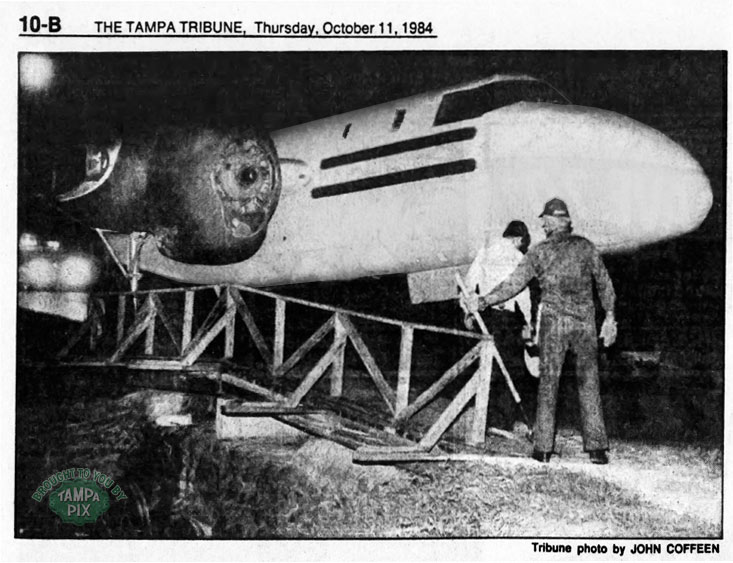 Once across the bay, the airplane inched its way to the St. Pete-Clearwater International Airport, arriving there shortly after 6 a.m. Morois did not know how much money had been spent in transporting the airplane from city to city. "It was a bunch of money, but it was mainly time spent by our volunteers, and a lot of caring." Morois said. "It was a very long night,"
|
||||
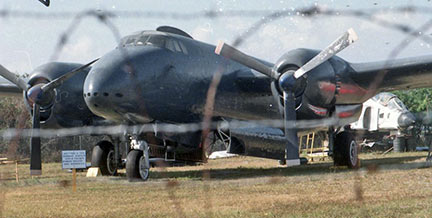
Read about the next life of this airplane, its restoration and its demise, here at TampaPix.
Lowry Park &
Fairyland
Herman - King of the Zoo
Safety Village / Children's Museum / Kids City